AZORES
Economy
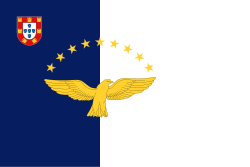
Economy
Popular destinations PORTUGAL
| Algarve | Azores | Costa de lisboa |
| Costa verde | Madeira |
Economy
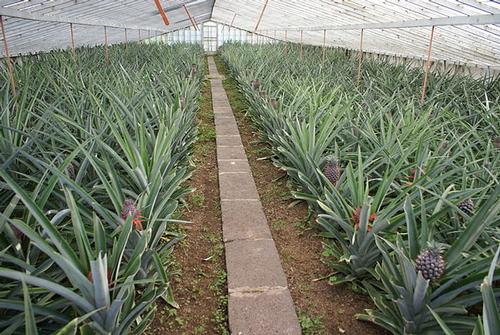 Pineapples are grown in greenhouses in the AzoresPhoto: José Luís Ávila Silveira/Pedro Noronha e Costa in the public domain
Pineapples are grown in greenhouses in the AzoresPhoto: José Luís Ávila Silveira/Pedro Noronha e Costa in the public domain
For thirty years before the economic crisis in Europe, the economic activities in the Azores were mainly in the field of infrastructure, including new airports, ports and telecommunication systems. As a result, the appearance of the Azores, and especially the capital Ponta Delgada, has changed considerably in recent years with industrial and commercial complexes on the outskirts of the city and many new shops in the city center. Most of these projects were mainly funded by the European Union, the flag of the European Union flew prominently on all of them.
The inhabitants of the fairly barren Azores live mainly from livestock farming and the production of milk, and those companies are present on every island. Wine grapes, pineapples, passion fruit, bananas and tea are also grown, but that is mainly for the islands themselves.
In the second half of the 19th century, farmers switched from orange production to pineapple production, especially in Fajã de Baixo near Ponta Delgada on the island of São Miguel. The pineapple plant originated in South America and was initially used only as an ornamental plant. The climate of the Azores is not suitable for this originally tropical fruit, which is why the pineapples, which have a special taste in the Azores, have been cultivated in greenhouses since 1864. At the height of the pineapple cultivation, there were about 3,000 greenhouses producing more than 2,000 tons of pineapples. The fertile region of Terra Chã on the island of Terceira is known for its sweet chestnut cultivation. The largest port in the Azores is that of the town of Praia da Vitória on the island of Terceira. São Miguel Island is the economic center of the Azores.
The Azores are actually the only place in 'Europe' where tea is grown. Two small plantations, Chá Porto Formoso (black tea only) and since 1883 Chá Gorreana (black and green tea), just east of Ribeira Grande on the island of Sãn Miguel, produce, today, about 40 tons of organically grown tea. In the 19th century there were fourteen tea factories, which, with a maximum production of 250 tons of tea, also produced for export. The reason that it is possible to grow tea in this place is because of the mild, rainy climate, comparable to, for example, the Chinese climate zone where growing tea is ideal. In some places, including São Jorge, coffee beans are grown on a small scale.
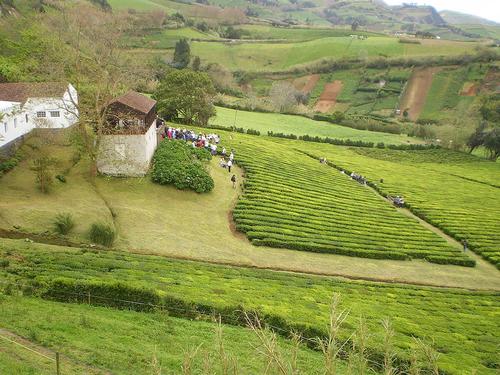 Chá Porto Formoso, tea plantation in the AzoresPhoto: Froth82 CC 3.0 Unported no changes made
Chá Porto Formoso, tea plantation in the AzoresPhoto: Froth82 CC 3.0 Unported no changes made
In the Azores, which are located in the middle of the ocean, fishing plays a smaller role than you would expect, only some canned tuna is exported from Rabo de Peixe, the largest fishing port in the Azores, to Italy. In Fajã Grande, tuna is still canned in the Fábrica Santa Catarina. Only 15 percent of the allowable catch quota is actually caught in the 38,000 square kilometer fishing area. The fishing boats are usually small and outdated and are located in the immediate vicinity of the islands. The fishing village of São Mateus da Calheta has a modern harbor on the island of Terceira with a trawler fleet. São Miguel and Graciosa, excellent wines. The wine is made from the ancient classical grape varieties Verdelho, Arinto and Terantez, which, together with the basalt walled (currais) vineyards (curraletas) and the wineries, belong to UNESCO's World Heritage. The 'currais', against the harmful wind, are a magnificent example of craftsmanship and perseverance, because if the often man-sized walls were laid one behind the other, one could easily build around the world. Lesser extent of Graciosa was exported to almost all continents from the 18th century, but this came to a cruel end when the phylloxera put an end to the export of the islands of Pico and Graciosa in the late 19th century. They mainly produce for their own use and on the island of Graciosa there is only one winery left: Terra do Conde. Well-known 'wine villages' are Biscoitos, Santa Luzia, Cabrito, Cais do Mourato, Porto do Cachorro and Lajido.
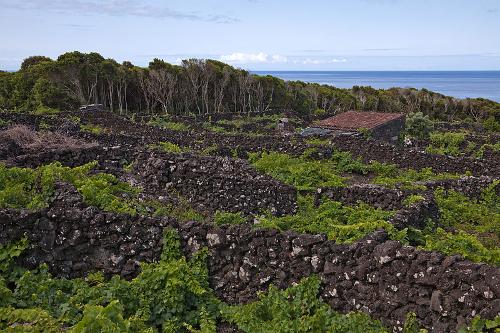 Walled 'currais' vineyard on Pico, AzoresPhoto: Unokorno CC 3.0 Unported no changes made
Walled 'currais' vineyard on Pico, AzoresPhoto: Unokorno CC 3.0 Unported no changes made
São Jorge is the cheese island of the Azores, and Queijo São Jorge is a trademark protected by the European Union. The first cheese recipes were introduced to the Azores by Flemish people who settled on the islands centuries ago. At the moment the Azores have about 200,000 black and white cows, of which about half are dairy cows that provide the raw milk from which the cheese is made. The special taste of the cheese is the result of mountain mint, which grows on the meadows, and the salt content of the air above the Azores.
Other well-known cheeses made from raw milk are Queijo Ilha Gracios Reserva, Queijo do Corvo and Queijo São João do Pico. The Queijo Ilha, Queijo Flamengo and Queijo Império do Pico made from pasteurized milk are of lesser quality. The various cheeses, including those from the other islands, are exported mainly to the Portuguese mainland and to Madeira.
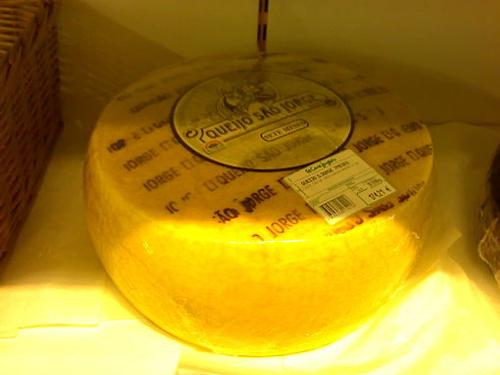 Queijo Sao Jorge, cheese from the AzoresPhoto: Adriao in the public domain
Queijo Sao Jorge, cheese from the AzoresPhoto: Adriao in the public domain
At the end of the 19th century, Maia and Lomba da Maia were two centers of tobacco production on São Miguel. At the moment there are only two factories active in Ponta Delgada. The factory in Maia closed in 1988 and reopened in 2008 as Museu do Tabaco. On the island of Pico in the town of Santo Amaro a ship repair yard. Santa Maria and Graciosa specialize in the cultivation of sugar melons.
Tourism is of great importance to the economy of the Azores. All islands together have about 10,000 beds for tourists, half of which are located on the main island of Sao Miguel. Most tourists have come from Germany for many years and the Azores are also popular with tourists from European countries such as Sweden, the Netherlands, Spain and of course mainland Portugal. Industry is hardly present in the archipelago. Furthermore, the Azores receive a lot of subsidy money from the European Union, because the remote archipelago is considered a somewhat backward fringe region.
Just like on mainland Portugal, ceramic production in the Azores is also important for the economy, even if it was just for the tourists. The big name in ceramics is Lagoa, a town on the island of São Miguel, successor of Vila Franca do Campo, where the Fábrica Cerámica Viera has been making the most beautiful things since 1862 and of very good quality. The crockery, vases and flower pots, known as Louça da Lagoa, are generally glazed in white and decorated with blue island-specific motifs. In Vila Franca do Campo there is still intact a collective ceramic furnace, where all the potters of the city used to bake their works. crochet and embroidery and woven blankets and tapestries for income not only from tourists but also from exports to countries such as Great Britain, the United States and France. A veritable industry has emerged in particular on the island of Terceira, where the finishing of the home-made hand-embroidered work is done in the factory.
Another typical handicraft of the island of Faial are works of art made from fig marrow are, the 'miolo de figueira'. Since the 16th century, the delicate artifacts have been made in women's monasteries and from 1834 by craftsmen. On the islands of Pico and São Miguel, a variant is being made, the escamas de peixe, in which the works of art are modeled with fish scales.
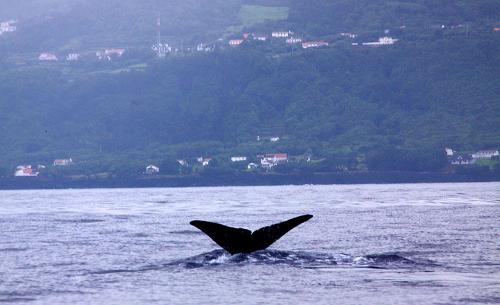 Whalewatching Pico, AzoresPhoto: Guillaume Baviere CC 2.0 Generic no changes made
Whalewatching Pico, AzoresPhoto: Guillaume Baviere CC 2.0 Generic no changes made
Until 1984, the island of Pico was the whaling island par excellence of the Azores. Until the 1950s, the whalers of Pico caught about 250 whales a year, in 1984 there were only about 50, too few to make it a profitable business. Nowadays Pico earns money with so-called 'whalewatching' and furthermore, a place like Lajes do Pico is completely dedicated to whaling in the museums Museu dos Baleeiros and the Centro de Artes e de Ciências do Mar, dvarious whaling cafes and in August the whaling festival Semana dos Baleeiros.
Since August 21, 1941, the Azores have their own airline company: SATA (Serviço Açoriano de Transportes Aéreos) Air Açores, based at João Paul II Airport in Ponta Delgada on the island of São Miguel.
Sources
BBC - Country Profiles
CIA - World Factbook
Elmar Landeninformatie
Lipps, Susanne / Azoren
ANWB
Marsh, Terry / Azores
New Holland
Martin, Roman / Azoren
Elmar
Sayers, David / Azores
Bradt Travel Guides
Stieglitz, Andreas / Landscapes of the Azores : a countryside guide
Sunflower Books
Wikipedia
Copyright: Team The World of Info